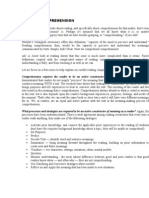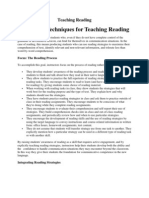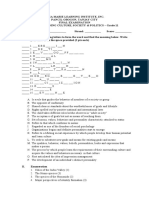0 ratings0% found this document useful (0 votes)
27 viewsAims of Teaching & Reading: Phrase
Aims of Teaching & Reading: Phrase
Uploaded by
Kirubah VijayakrishnanThe document discusses several aims of teaching reading: 1) Helping pupils become independent readers, 2) Teaching comprehension strategies like using dictionaries, 3) Developing students' ability to respond individually to texts, and 4) Helping pupils read at an appropriate speed and silently. It also describes Barrett's Taxonomy for categorizing reading comprehension questions into literal, inferential, evaluative, and appreciative.
Copyright:
Attribution Non-Commercial (BY-NC)
Available Formats
Download as PPT, PDF, TXT or read online from Scribd
Aims of Teaching & Reading: Phrase
Aims of Teaching & Reading: Phrase
Uploaded by
Kirubah Vijayakrishnan0 ratings0% found this document useful (0 votes)
27 views13 pagesThe document discusses several aims of teaching reading: 1) Helping pupils become independent readers, 2) Teaching comprehension strategies like using dictionaries, 3) Developing students' ability to respond individually to texts, and 4) Helping pupils read at an appropriate speed and silently. It also describes Barrett's Taxonomy for categorizing reading comprehension questions into literal, inferential, evaluative, and appreciative.
Original Title
eng1
Copyright
© Attribution Non-Commercial (BY-NC)
Available Formats
PPT, PDF, TXT or read online from Scribd
Share this document
Did you find this document useful?
Is this content inappropriate?
The document discusses several aims of teaching reading: 1) Helping pupils become independent readers, 2) Teaching comprehension strategies like using dictionaries, 3) Developing students' ability to respond individually to texts, and 4) Helping pupils read at an appropriate speed and silently. It also describes Barrett's Taxonomy for categorizing reading comprehension questions into literal, inferential, evaluative, and appreciative.
Copyright:
Attribution Non-Commercial (BY-NC)
Available Formats
Download as PPT, PDF, TXT or read online from Scribd
Download as ppt, pdf, or txt
0 ratings0% found this document useful (0 votes)
27 views13 pagesAims of Teaching & Reading: Phrase
Aims of Teaching & Reading: Phrase
Uploaded by
Kirubah VijayakrishnanThe document discusses several aims of teaching reading: 1) Helping pupils become independent readers, 2) Teaching comprehension strategies like using dictionaries, 3) Developing students' ability to respond individually to texts, and 4) Helping pupils read at an appropriate speed and silently. It also describes Barrett's Taxonomy for categorizing reading comprehension questions into literal, inferential, evaluative, and appreciative.
Copyright:
Attribution Non-Commercial (BY-NC)
Available Formats
Download as PPT, PDF, TXT or read online from Scribd
Download as ppt, pdf, or txt
You are on page 1of 13
AIMS OF TEACHING & READING
Teaching reading involves teaching basic word,
phrase and sentence recognition, as well as the
ability to retrieve information contained in texts. But
there are some other aims that are often neglected.
Lets us look more closely at each one of these
additional aims:
Objectives of the KBSR
-3M (Reading, Writing, Counting)
- Skills ~ speak, listen, read, write & basic numerical skills
(add, subtract, multiply, divide)
Objectives of the KBSM
-read & understand purpose and poetry for in formation
and enjoyment.
-student to retrieve information contained in texts .
ADDITIONAL AIMS
Help pupils to become independent readers.
The benefits of being a frequent and enthusiastic reader
are well documented. The more you read and enjoy
reading, the better and more confident you become at
reading and the more you want to do it. Creating skilled,
confident readers who are eager to access the curriculum
is the fundamental way in which the Reading Connects
approach can help your school.
Teach them how to use dictionary an index, a table of
contents and so on.
For example :when the student doing homework or self
reading, they might use on of this items to improve
understanding.
DEVELOP RESPONSE TO TEXT
Recognize that pupils are individuals that they must
learn to respond as individual to the text they read.
Before students read a selection, the teacher uses the
text map to support an interactive introduction of the
text. After students have read the text, they revisit the
text map to modify and to elaborate on their initial
response. In this way, they further build their
understanding of the relationships between the
organizational features of the text and what they
learned.
HELP PUPILS READ WITH ADEQUATE
UNDERSTANDING
Pupils does not have to understand everything in a text.
He needs to understand only what is important for his
purpose.
The best methods of teaching comprehension strategies
are systematic and include direct explanation by the
teacher, modelling by the teacher, guided practice by the
teacher, application by the pupil with help of the teacher.
To teach children to point out hard to understand parts of
text and then to look for solutions while rereading sections
for clues. To answer questions that help pupils focus on
important points in a text. To make up questions.
For example: after guiding them, give some question
regards on items which student feel difficult to understand
HELP PUPILS READ AT APPROPRIATE
SPEED
Get texts that pupils can read comfortably, at the
speed the kind of text you have chosen is normally
read.
Begin with simple text to avoid word stumbling over
every other word in the story or text.
Practice, – you have to use your skills on a regular
basis. It took you several years to learn to read, and it
will take time to improve your reading skill.
HELP PEOPLE READ AT APPROPRIATE
SPEED
Choose easy material to start – when you begin speed
reading, don't attempt it with a challenging textbook. Read
something like a novel or travel-writing, that you can
realistically comprehend with a quick once-over.
Use a pointer or other device to help push your reading
speed – when you quickly draw a card down the page or
run your finger back and forth you force your eyes and
brain to keep pace.
Take a step back and use the material's structure – this
includes skimming information to get a feel for the
organization and l looking for the ways in which the author
transitions from one topic to the next.
HELP PUPILS READ SILENTLY
It will make you read faster- When you read silently, you
reduce your reading speed and therefore cover more
learning ground
It Will Improve your Understanding-As said above, when
you read out loud you are concentrating on your
pronunciation rather than reading the words in front of
you. You absorb much more information, and understand
more.
It Will Help You With Your Pronunciation -When reading
English text silently, you can ‘hear’ the words as you read
them.
Helps You To Filter Out The Information-When you read
aloud you have no option but to read every single word you
come across
Helps Exam Skills-If you are taking a course with a final
exam, you won’t be allowed to read the questions or
problems out loud.
Teaching reading means enabling a person to acquire
the skills, strategies and attitudes required to make
sense of text.
BARRETT’ S TAXONOMY
Literal recognition or recall
- Understanding of information that is explicitly stated in
the text. Such questions ensure that the views and
information overtly expressed in the text are understood.
- Recall of main ideas, details sequence, cause-effect
relationships, character traits.
example: -The student is requested to identify or locate or
to call up from memory statements about a character
which help to point up the type of person he was, when
such statements were made by the author of the selection
Inference
- drawing conclusions not stated in the text but implied by
the facts given. The reader uses knowledge of linguistic
implications, logic previous knowledge of related
situations.
example: inferring main ideas ,supporting ,details ,
sequence ,cause-effect relationships, predicting outcomes.
- The student is required to infer likenesses and differences
in characters, times, or places. Such inferential
comparisons revolve around ideas such as "here and there",
"he and she", and "she and she
Evaluation
- judgments about whether something is real or
imaginary, whether it is appropriate, worthwhile,
desirable or acceptable. Evaluation involves values
and therefore there is usually no ‘CORRECT’ answer
to questions involve evaluation.
- for exchange of views and interpretations. They can
be very enjoyable.
example:- Judgments of Reality or Fantasy, Judgments of
Adequacy or Validity, Judgments of Appropriateness,
Judgments of worth, Desirability or Acceptability
Appreciation
- Emotional response to plot or them; reactions to the
author's use of language. Appreciation involves the
taste. Again there are no correct answers.
-opportunities for exchange of views and
interpretations again make these question very
enjoyable.
Example:- Emotional Response to the Content,
Identification with Characters and Incidents, Reactions to
the Author's Use of Language and Imagery
You might also like
- Fifty Ways to Teach Reading: Fifty Ways to Teach: Tips for ESL/EFL TeachersFrom EverandFifty Ways to Teach Reading: Fifty Ways to Teach: Tips for ESL/EFL TeachersRating: 4 out of 5 stars4/5 (3)
- School-Based Inset 2020Document47 pagesSchool-Based Inset 2020Mhilgene Briones Manalo100% (5)
- BayerDocument22 pagesBayermatheuNo ratings yet
- 3 R Eceptive Skills: Reading: How Can You Help Your Students Improve Their Reading?Document5 pages3 R Eceptive Skills: Reading: How Can You Help Your Students Improve Their Reading?Anita MadunovicNo ratings yet
- Cognitive Processing: Selection of Text / StrategyDocument4 pagesCognitive Processing: Selection of Text / Strategyapi-77020443No ratings yet
- Developing Reading ActivitiesDocument3 pagesDeveloping Reading ActivitiesbaewonNo ratings yet
- Teaching Reading and WritingDocument33 pagesTeaching Reading and WritingJESSICA ROSETE50% (2)
- Reading Process Stages of Reading: Pre-Reading Before Readaing During Reading After ReadingDocument4 pagesReading Process Stages of Reading: Pre-Reading Before Readaing During Reading After ReadingAbegail LaurenteNo ratings yet
- TSL 3106 NotesDocument28 pagesTSL 3106 NotesAg Muhammad ZakieNo ratings yet
- Testing Reading FinalDocument7 pagesTesting Reading Finallevel xxiiiNo ratings yet
- ReadingListening KeyIdeasDocument5 pagesReadingListening KeyIdeasSamira Alves GülüNo ratings yet
- Reading Comprehension Strategies Language Arts 6th GradeDocument20 pagesReading Comprehension Strategies Language Arts 6th GradeRonelle San buenaventuraNo ratings yet
- Focus: The Reading ProcessDocument9 pagesFocus: The Reading ProcessJolens VelasquezNo ratings yet
- Topic2 Meeting 2Document15 pagesTopic2 Meeting 2Marta DelvaNo ratings yet
- How To Improve Reading Comprehension SkillsDocument8 pagesHow To Improve Reading Comprehension SkillsRsksamyNo ratings yet
- ReadingDocument10 pagesReading24104No ratings yet
- Teaching ReadingDocument11 pagesTeaching ReadingVen KeraNo ratings yet
- March26 English DidacticDocument8 pagesMarch26 English DidacticMarcus WeidNo ratings yet
- Teaching ReadingDocument12 pagesTeaching ReadingDado Dodo100% (1)
- Different Types of Reading Skills and Strategies - Reading AbilityDocument9 pagesDifferent Types of Reading Skills and Strategies - Reading AbilityMuneeb U RahmanNo ratings yet
- Teaching The Reading SkillDocument37 pagesTeaching The Reading Skillinspectmed05No ratings yet
- Reading Comprehension and Academic PerformanceDocument9 pagesReading Comprehension and Academic PerformanceMelanieNo ratings yet
- There Are Ten Basic Skills That AppliedDocument8 pagesThere Are Ten Basic Skills That AppliedCh ArmanNo ratings yet
- Reading and Listening ComprehensionDocument18 pagesReading and Listening ComprehensionmuhasadNo ratings yet
- Unit 1 and 2 CE-OCTDocument49 pagesUnit 1 and 2 CE-OCTmerp7gt650twinNo ratings yet
- Module 7english Language Arts ReportDocument67 pagesModule 7english Language Arts ReportJERVOSO, DANJIE R.No ratings yet
- Here Are The Seven Must Teach Comprehension StrategiesDocument8 pagesHere Are The Seven Must Teach Comprehension StrategiesBashar AhmadNo ratings yet
- Teaching ReadingDocument3 pagesTeaching ReadingNguyen Van TuyenNo ratings yet
- Detailed Notes TSL 3106Document31 pagesDetailed Notes TSL 3106Adam PrinceNo ratings yet
- Hafifah Dwi LestariDocument9 pagesHafifah Dwi LestariHafifah dwi lestariNo ratings yet
- Monitoring ComprehensionDocument5 pagesMonitoring ComprehensionAndrea JoanaNo ratings yet
- Teaching Reading Theory 20 Copies PDFDocument7 pagesTeaching Reading Theory 20 Copies PDFDN MukhiyaNo ratings yet
- How To Teach Reading ComprehensionDocument5 pagesHow To Teach Reading ComprehensionReyaaz KarjiekerNo ratings yet
- Teaching Reading-Reading StrategiesDocument2 pagesTeaching Reading-Reading StrategiessusudoNo ratings yet
- Teaching Reading SkillDocument6 pagesTeaching Reading SkillAiman QamarNo ratings yet
- Ten Steps To Effective Listening: Taking Notes Analyzing and Synthesizing What Is Read Figurative LanguageDocument4 pagesTen Steps To Effective Listening: Taking Notes Analyzing and Synthesizing What Is Read Figurative LanguageLydia ElaNo ratings yet
- Summary Unit 3Document21 pagesSummary Unit 3Elena SucoNo ratings yet
- Methodology ExamDocument113 pagesMethodology ExamLeyla AliyevaNo ratings yet
- Prediction As Pre-Reading Activity: Prediction Is One of The ManyDocument12 pagesPrediction As Pre-Reading Activity: Prediction Is One of The ManyJodilyn OcampoNo ratings yet
- Reciprocal Teaching: Submitted byDocument43 pagesReciprocal Teaching: Submitted byakashNo ratings yet
- Teaching Receptive and Productive SkillsDocument37 pagesTeaching Receptive and Productive SkillsNurul HanisahNo ratings yet
- Goals and Techniques For Teaching ReadingDocument3 pagesGoals and Techniques For Teaching ReadingNurul HudaNo ratings yet
- What Is Reading ComprehensionDocument12 pagesWhat Is Reading ComprehensionIoana DuminicelNo ratings yet
- Content Area ReadingDocument30 pagesContent Area ReadingJohnjohn GalanzaNo ratings yet
- Grouping TELLDocument5 pagesGrouping TELLSyahmi SyihabuddinNo ratings yet
- Efficient Reading SkillsDocument12 pagesEfficient Reading Skillskiran100% (1)
- Teaching Method - Reading Approach 2Document8 pagesTeaching Method - Reading Approach 2djoiajgNo ratings yet
- Topic 3Document11 pagesTopic 3Wan Amir Iskandar IsmadiNo ratings yet
- Extensive Reading DoneDocument7 pagesExtensive Reading Donesuci apriliana pertiwiNo ratings yet
- Read 436 Exit Slips - Jessica ThoppilDocument5 pagesRead 436 Exit Slips - Jessica Thoppilapi-356075811No ratings yet
- ExamDocument19 pagesExampasevichsonaNo ratings yet
- Teaching English in The Elementary GradesDocument3 pagesTeaching English in The Elementary GradesGrald Traifalgar Patrick ShawNo ratings yet
- 514 Reading Strategies Week 3 Self-Assessment Definitions and HighlightsDocument5 pages514 Reading Strategies Week 3 Self-Assessment Definitions and Highlightsapi-427648228No ratings yet
- Goals and Techniques of Reading Skills Thesis PreparationDocument45 pagesGoals and Techniques of Reading Skills Thesis PreparationRangothri Sreenivasa SubramanyamNo ratings yet
- TEACHING - READING - The Nature of ReadingDocument22 pagesTEACHING - READING - The Nature of ReadingManuel Arlindo JaimeNo ratings yet
- Reading and Word-Attack Strategies - Reading A-ZDocument3 pagesReading and Word-Attack Strategies - Reading A-ZRoberta NoélliaNo ratings yet
- How To Teach A - PDP - Reading LessonDocument2 pagesHow To Teach A - PDP - Reading LessonMr Samir Bounab93% (15)
- 1.reading Comprehension Is The Level of Understanding of A Text/message. This UnderstandingDocument9 pages1.reading Comprehension Is The Level of Understanding of A Text/message. This UnderstandingAirlia Lou CorpinNo ratings yet
- John Austin's Theory of SovereigntyDocument10 pagesJohn Austin's Theory of SovereigntyAkshansh BhadouriyaNo ratings yet
- Fee Notification LFBADocument14 pagesFee Notification LFBAprerna guptaNo ratings yet
- Theories of State and Law, Gwisai MDocument21 pagesTheories of State and Law, Gwisai Mmitchel gwatidzoNo ratings yet
- Electrical System in AutomobileDocument13 pagesElectrical System in AutomobileRohit kendreNo ratings yet
- Stages of A Crime Criminal Law...Document3 pagesStages of A Crime Criminal Law...abhijeet sharmaNo ratings yet
- Nonmaterial Requirements: FOR Uninterruptible Power Supply (Ups)Document3 pagesNonmaterial Requirements: FOR Uninterruptible Power Supply (Ups)junaid ShahNo ratings yet
- Answer Key To Extra Reading Comprehension Exercises: Unit 1, Page 10 Comprehension QuestionsDocument7 pagesAnswer Key To Extra Reading Comprehension Exercises: Unit 1, Page 10 Comprehension QuestionsAnonymous 46c1dDMNo ratings yet
- Submittal Transmittal Sheet #: Project Name DB52-TH16-PQN-001 00 Submittal Title: Prequalification For ANTI TERMITEDocument1 pageSubmittal Transmittal Sheet #: Project Name DB52-TH16-PQN-001 00 Submittal Title: Prequalification For ANTI TERMITESasi KumarNo ratings yet
- Rigor and Grounded Theory ResearchDocument9 pagesRigor and Grounded Theory ResearchHyojin ImNo ratings yet
- Ucsp G11Document2 pagesUcsp G11LudyNo ratings yet
- Mansoor Ahmed Khan Research PaperDocument20 pagesMansoor Ahmed Khan Research PaperMansoor Ahmed KhanNo ratings yet
- Go To PageDocument4 pagesGo To Pageapi-506774410No ratings yet
- A, Traditional Tax System Prior To 1941-In The Axumite Kingdom, There Was A Practice of TraditionalDocument7 pagesA, Traditional Tax System Prior To 1941-In The Axumite Kingdom, There Was A Practice of Traditionalliya100% (2)
- Matter and Material: Water Purification For Grade 6. Pertinent QuestionsDocument1 pageMatter and Material: Water Purification For Grade 6. Pertinent QuestionsLiana MatgetloaNo ratings yet
- ExaminationDocument11 pagesExaminationАлександр СвирновскийNo ratings yet
- Crane Customer Care LayerDocument8 pagesCrane Customer Care Layeradnan altawilyNo ratings yet
- Competency Proficiency Assessment OrientationDocument44 pagesCompetency Proficiency Assessment OrientationKrisna May Buhisan PecoreNo ratings yet
- Hare Psychopathy ChecklistDocument2 pagesHare Psychopathy ChecklistDJSeidel80% (5)
- Kousali Institute of Management Studies, DharwadDocument33 pagesKousali Institute of Management Studies, DharwadRoronoa ZoldyckNo ratings yet
- Imani Harvey ResumeDocument1 pageImani Harvey Resumeapi-506802049No ratings yet
- Book 1 - Hans Von BalthasarDocument3 pagesBook 1 - Hans Von BalthasarPedro Augusto Fernandes PalmeiraNo ratings yet
- Ip June YanyanDocument2 pagesIp June YanyanYanyan AlfanteNo ratings yet
- Fig 1.1: EscalatorDocument6 pagesFig 1.1: Escalatorsaleh gaziNo ratings yet
- Use of Virtual Reality in Auditing Addtl HandoutsDocument10 pagesUse of Virtual Reality in Auditing Addtl HandoutsJessel QuirequireNo ratings yet
- Education Environment in Public and Private SectorDocument2 pagesEducation Environment in Public and Private SectornanabirjuNo ratings yet
- Stacy Adams Equity TheoryDocument13 pagesStacy Adams Equity TheoryFajar nNo ratings yet
- Peer Support DefinedDocument11 pagesPeer Support DefinedShandy PutraNo ratings yet
- The Casting Director: by Kate McclanaghanDocument3 pagesThe Casting Director: by Kate McclanaghanmaniNo ratings yet
- Medical Problems Vocabulary: Lesson FocusDocument2 pagesMedical Problems Vocabulary: Lesson FocusOlya SaichukNo ratings yet

























































































